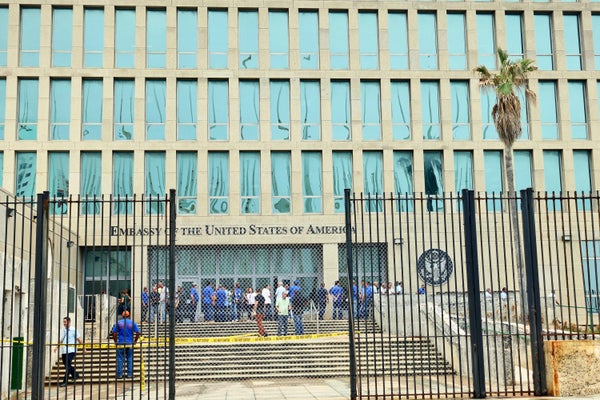Soviet-Era Pseudoscience Lurks behind ‘Havana Syndrome’ Worries
Dodgy studies and fantastic claims have long powered a belief in devious Russian brain weapons, from mind control to microwave devices
Personnel gathered at the U.S. Embassy in Cuba on September 29, 2017 in Havana, Cuba.
Sven Creutzmann/Mambo Photo/Getty Images
In the 1970s U.S. spy agencies believed that Soviet scientists were using telepathy and other supposed paranormal abilities to develop mind-control weaponry. U.S. Army and Air Force journals fretted about a “new mental battlefield” of “psychic warfare.”
If you saw The Men Who Stare at Goats, based on the non-fiction book by Jon Ronson, or read Annie Jacobsen’s Phenomena: The Secret History of the U.S. Government’s Investigations into Extrasensory Perception and Psychokinesis, then you know what happened next. The Defense Department for the next two decades squandered millions of dollars on ridiculous “psychic spy” research. It recruited paranormal enthusiasts to practice levitating and walking through walls, among other absurdities.
Most of us now chuckle at this screwball chapter of the cold war annals. But the roots of it, which can be traced to a wellspring of bogus Soviet-era studies fed to visiting American researchers and writers, is worth revisiting to better understand how the U.S. intelligence community got suckered into (and distracted by) a decades-long enchantment with the pseudoscience of parapsychology.
On supporting science journalism
If you’re enjoying this article, consider supporting our award-winning journalism by subscribing. By purchasing a subscription you are helping to ensure the future of impactful stories about the discoveries and ideas shaping our world today.
That history today offers us insight into the origin of Havana syndrome, the controversial medical condition best known for afflicting U.S. diplomats and intelligence officials. Many victims of these “anomalous health incidents” believe they suffer from brain injuries from a secret Russian acoustic or radiological microwave weapon. (Their symptoms include headaches, vertigo and fatigue.) Experts have pointed out why this is scientifically implausible. Moreover, federal investigators have found no trace of such a weapon. And a recent comprehensive National Institutes of Health study revealed no physical evidence of brain damage in self-identified victims—many who are former government personnel who worked in the State Department and CIA .
So why does the notion (especially in the news media) still persist that Russia is attacking people with some kind of portable directed energy device? Well, for starters, Russia has boasted of creating such a brain weapon, in various forms over many decades. In the 1990s, American cold warriors pivoted from worrying about Soviet psychic warfare to “psycho-terrorism,” which they read about in Russian media. These new “psychotronic weapons,” as the Russians dubbed them, were powered by x-rays, ultrasound and radio waves, and “used against the mind to induce hallucinations, sickness, mutations in human cells, ‘zombification,’ or even death,” wrote military analyst Timothy L. Thomas in the U.S. Army War College’s quarterly journal Parameters.
If American national security experts took Russia at its word, why shouldn’t influential Havana syndrome proponents, who frequently cite dated Russian studies on health effects from exposure to microwave radiation?
This includes David Relman, a professor of medicine at Stanford, who in one 2021 NBC interview, points vaguely to this decades-old “Russian literature” as evidence for a “deliberate” use of “pulsed microwave energy” in the Havana Syndrome incidents. Relman, notably, headed a controversial 2020 National Academy of Sciences report, which concluded that “directed pulsed RF [radio frequency] energy” was “the most plausible mechanism” for Havana syndrome symptoms.
Never mind that the NAS report provided no biological basis for this claim. But it did cite “significant research in Russia/USSR” that examined military personnel exposed to pulsed microwave radiation. (Perhaps they were the test subjects for Putin’s “zombie” ray gun.) These studies supposedly found that individuals suffered dizziness, depression, headaches and fatigue, among other ill effects (all which happen to match up with the symptoms reported by Havana syndrome victims). Oh, and by the way: the NAS report also acknowledges that “many of the studies from the former Soviet Union were flawed in one or more ways.”
Somehow this dodgy Soviet-era science became the backbone for the microwave weapon theory. Its flimsy rationale defies both common sense and critical scrutiny. And yet, reputable journalism outlets contort themselves to make the argument. The latest example is an April 60 Minutes segment that suggested a dastardly Russian intelligence cell zapped U.S. officials all over the globe, including inside the White House. The 60 Minutes story, as skeptics noted, is fraught with illogical leaps and convenient omissions.
In response, adherents of the Russian microwave weapon theory have pointed to a long and detailed article published by The Insider, an investigative journalistic website that teamed up with 60 Minutes. But if you read the fine print, its story ultimately falls back on—you guessed it—a “corpus of scientific literature” from the Soviet Union, including a 1974 Soviet patent that claimed to successfully test a device that used radio waves to put people to sleep.
This reminded me of the infamous account of the Soviet psychic who could stop a frog’s heart with her mind, one of the many fantastical tales of Russian psychic prowess chronicled by American authors in the 1970s. There was a KGB-sponsored pipeline of this stuff that American readers ate up and that seemingly induced the U.S. intelligence community to fall down its paranormal rabbit hole.
As the intelligence historian Filip Kovačević explained to me, psychic phenomena were at this time incompatible with Marxist (e.g., materialist) ideology in the U.S.S.R. But ESP (extrasensory perception) was all the rage in America’s Age of the Aquarius, and the Soviets took notice. “That was something the Westerners wanted to hear (especially in the late 1960s and early 1970s) and the KGB supplied them with it,” he said to me in an e-mail. “My sense is that most of what was known about Soviet science in the West during the [cold war] was a result of KGB disinformation.”
To suggest that the victims of Havana syndrome are just the latest in a long line of KGB dupes would be simplistic and insulting. I don’t question their sincerity or the pain they have experienced, some still with debilitating injuries. At this juncture, the psychogenic theory strikes me as the most plausible explanation, particularly for those individuals working in a high stress environment, who might also have had earlier injuries. But we can also fault bad journalism, bad science and an inept bureaucracy for the growth of Havana syndrome as a sociocultural phenomenon.
It also seems possible that Havana syndrome is a byproduct of the recently heightened tensions between Russia and the United States that have been building since the 2014 seizure of Crimea that preceded the current war in Ukraine. It’s worth remembering that the cold war in the 20th century between the two superpowers was rife with mutual paranoia and misinterpretations. In the 2010s, as tensions with China and Russia heightened, the concept of neurowarfare gained traction in military and intelligence circles. The concern here is that America’s foreign adversaries will develop nonlethal but incapacitating weapons that strike at the brain, via a chemical or biological agent or portable radiological device.
One of the leading Havana syndrome conceptualists is Georgetown University neuroscientist James Giordano, who is adamant that victims were attacked with a sonic or microwave weapon. He has argued this since 2018 and been an influential advisor on the issue to the U.S. government. Today, the idea of neurowarfare is regarded as a fait accompli by up-and-coming thinkers in the military. Havana syndrome’s emergence and the National Academy of Sciences report’s conclusions have cinched it.
In the intelligence world, U.S. analysts are taught to be vigilant to cognitive biases that might confirm a preconception. Our adversaries have long sought to exploit such biases as a form of neurowarfare. In the end, that might be the real Havana syndrome.
This is an opinion and analysis article, and the views expressed by the author or authors are not necessarily those of Scientific American.








:quality(85):upscale()/2024/06/24/971/n/24155406/6f126bec6679f0b3af1f19.82447124_.png)


:quality(85):upscale()/2024/06/12/903/n/49351082/7631d470666a07c3335f26.46595754_.jpg)



